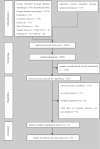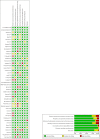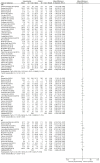Effects of high-intensity interval training on physical morphology, cardiorespiratory fitness and metabolic risk factors of cardiovascular disease in children and adolescents: A systematic review and meta-analysis
- PMID: 37167291
- PMCID: PMC10174557
- DOI: 10.1371/journal.pone.0271845
Effects of high-intensity interval training on physical morphology, cardiorespiratory fitness and metabolic risk factors of cardiovascular disease in children and adolescents: A systematic review and meta-analysis
Abstract
Objective: To systematically evaluate the safety and efficacy of high-intensity interval training in children and adolescents.
Methods: Eight databases were searched. Descriptive analysis of the efficacy and safety of high-intensity interval training on body shape, cardiorespiratory fitness, and metabolic risk markers of cardiovascular disease in children and adolescents. Subgroup analysis was performed using age, participants, intervention time, and exercise frequency as covariates.
Results: 47 studies included 2995 children and adolescents. The results of the meta-analysis showed that high-intensity interval training significantly improved cardiorespiratory fitness indicators (VO2max, SBP, DBP and HRmax) and cardiovascular disease biomarkers (TC and HDL-C). HIIT had no significant effect on body shape indicators (BMI, BF% and WC) or cardiovascular disease biomarkers (TG and LDL-C).
Conclusion: Currently, there is insufficient evidence that HIIT with interval running as the predominant form improves physical indicators in children and adolescents. However, HIIT can be promoted in children and adolescents to improve cardiorespiratory fitness and reduce some metabolic risk of cardiovascular disease.
Copyright: © 2023 Men et al. This is an open access article distributed under the terms of the Creative Commons Attribution License, which permits unrestricted use, distribution, and reproduction in any medium, provided the original author and source are credited.
Conflict of interest statement
The authors have declared that no competing interests exist.
Figures







References
-
- WHO. Global action plan on physical activity 2018–2030: more active people for a healthier world. World Health Organization. 2018.
-
- Liu J, Zhu L, Su Y. Comparative Effectiveness of High-Intensity Interval Training and Moderate-Intensity Continuous Training for Cardiometabolic Risk Factors and Cardiorespiratory Fitness in Childhood Obesity: A Meta-Analysis of Randomized Controlled Trials. FRONT PHYSIOL. 2020 2020-04-03;11. doi: 10.3389/fphys.2020.00214 - DOI - PMC - PubMed
-
- Meng C, Yucheng T, Shu L, Yu Z. Effects of school-based high-intensity interval training on body composition, cardiorespiratory fitness and cardiometabolic markers in adolescent boys with obesity: a randomized controlled trial. BMC PEDIATR. 2022;22(1). doi: 10.1186/s12887-021-03079-z - DOI - PMC - PubMed
Publication types
MeSH terms
Substances
LinkOut - more resources
Full Text Sources
Miscellaneous

